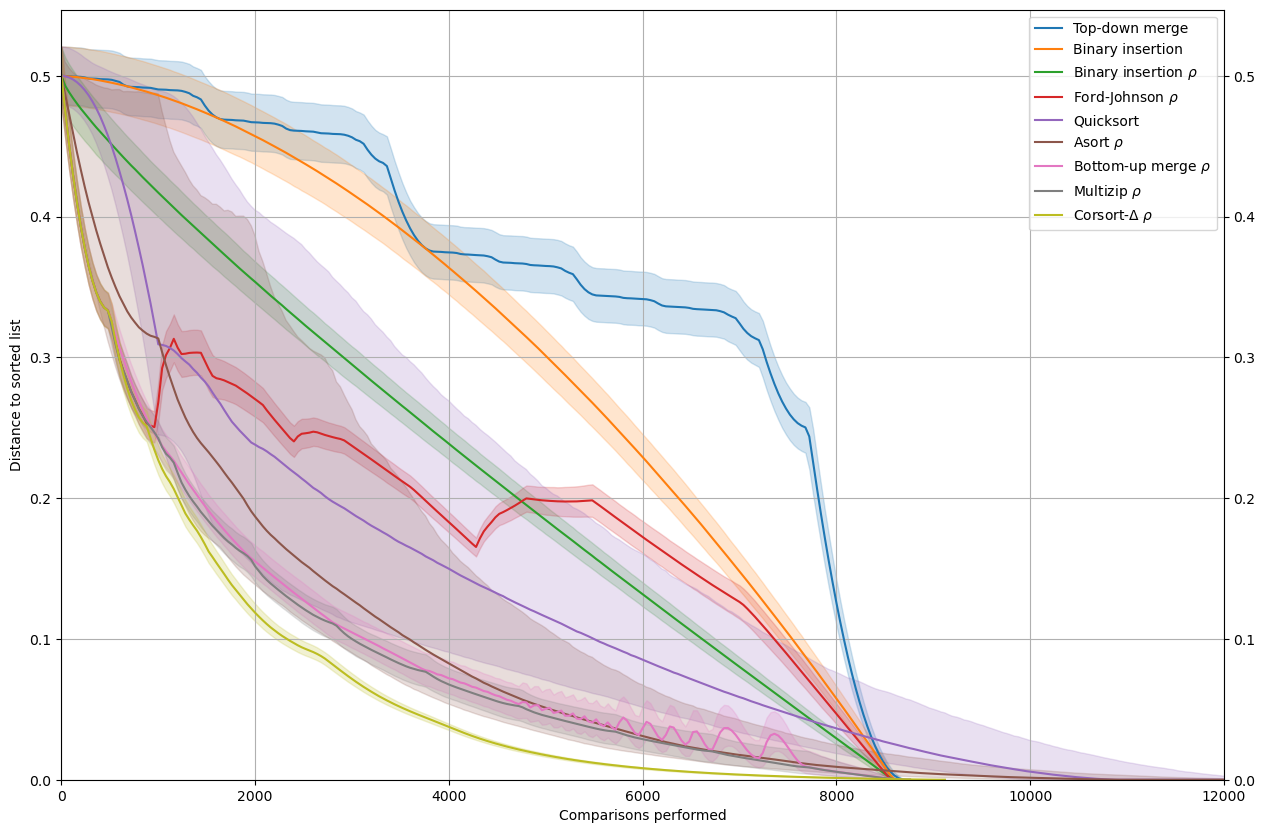Performance profiles
This notebook shows how to use the corsort package to determine the performance profiles of several sorting algorithms.
Here the following sorts will be compared:
Top-down merge
Binary insertion
Binary insertion \(\rho\)
Ford-Johnson \(\rho\)
Quicksort
ASort \(\rho\)
Bottom-up merge \(\rho\)
Multizip \(\rho\)
Corsort \(\rho\)
First we load some packages.
[1]:
import numpy as np
from matplotlib import pyplot as plt
from multiprocess.pool import Pool
from corsort import *
We populate the list of sorts we want to study. As we consider profiles, the scorer used matters (here \(\rho\) is the main external scorer).
[2]:
sort_list = [
SortMergeTopDown(compute_history=True),
SortBinaryInsertion(compute_history=True),
WrapSortScorer(sort=SortBinaryInsertion(), scorer=jit_scorer_rho, compute_history=True),
WrapSortScorer(sort=SortFordJohnson(), scorer=jit_scorer_rho, compute_history=True),
SortQuick(compute_history=True),
WrapSortScorer(sort=SortAsortQuickselect(), scorer=jit_scorer_rho, compute_history=True),
WrapSortScorer(sort=SortMergeBottomUp(), scorer=jit_scorer_rho, compute_history=True),
WrapSortScorer(sort=SortMultizip(), scorer=jit_scorer_rho, compute_history=True),
JitCorsortDeltaMaxRho(compute_history=True)
]
legends = {'mergesort_top_down': 'Top-down merge',
'binary_insertion_sort': 'Binary insertion',
'binary_insertion_sort_rho': r'Binary insertion $\rho$',
'ford_johnson_rho': r'Ford-Johnson $\rho$',
'quicksort': 'Quicksort',
'asort_quickselect_rho': r'Asort $\rho$',
'mergesort_bottom_up_rho': r'Bottom-up merge $\rho$',
'multizip_sort_rho': r'Multizip $\rho$',
'corsort_delta_max_rho': r"Corsort-$\Delta$ $\rho$"}
We decide the value of \(n\) to study and the number of trials.
[3]:
n = 1000
nt = 10000
We now run the experiments, with some multi-processing to speed-up things.
[4]:
with Pool() as p:
convergence = evaluate_convergence(sort_list=sort_list, n=n, nt=nt, pool=p)
Evaluate convergence of mergesort_top_down for n = 1000
100%|██████████| 10000/10000 [28:20<00:00, 5.88it/s]
Evaluate convergence of binary_insertion_sort for n = 1000
100%|██████████| 10000/10000 [29:23<00:00, 5.67it/s]
Evaluate convergence of binary_insertion_sort_rho for n = 1000
100%|██████████| 10000/10000 [58:20<00:00, 2.86it/s]
Evaluate convergence of ford_johnson_rho for n = 1000
100%|██████████| 10000/10000 [1:08:32<00:00, 2.43it/s]
Evaluate convergence of quicksort for n = 1000
100%|██████████| 10000/10000 [40:55<00:00, 4.07it/s]
Evaluate convergence of asort_quickselect_rho for n = 1000
100%|██████████| 10000/10000 [1:35:46<00:00, 1.74it/s]
Evaluate convergence of mergesort_bottom_up_rho for n = 1000
100%|██████████| 10000/10000 [49:53<00:00, 3.34it/s]
Evaluate convergence of multizip_sort_rho for n = 1000
100%|██████████| 10000/10000 [52:46<00:00, 3.16it/s]
Evaluate convergence of corsort_delta_max_rho for n = 1000
100%|██████████| 10000/10000 [2:42:29<00:00, 1.03it/s]
We save the raw results.
[5]:
import dill as pickle
from pathlib import Path
fn = Path(f"profiles_n_{n}_nt_{nt}.pkl")
if fn.exists():
with open(fn, 'rb') as f:
convergence = pickle.load(f)
else:
with open(fn, 'wb') as f:
pickle.dump(convergence, f)
Then we display the results.
[6]:
m = n*(n-1)/2
fig = plt.figure(figsize=(15, 10))
ax = plt.axes()
decim=40
color_dict = auto_colors(sort_list)
for name in legends:
ref = convergence[name]
color = color_dict[name]
p_m = ref.shape[1]
x = np.arange(p_m)[::decim]
ref = ref[:, ::decim]
q = np.zeros((5, ref.shape[1]))
for i, per in enumerate([2.5, 50, 97.5]):
q[i, :] = np.percentile(ref, per, axis=0)
q = q/m
ax.plot(x, q[1, :], label=legends[name], color=color)
ax.fill_between(x, q[0, :], q[2, :], alpha=.2, color=color)
plt.legend()
plt.grid()
ax.tick_params(labelright=True, right=True)
plt.ylabel('Distance to sorted list')
plt.xlabel('Comparisons performed')
plt.ylim([0, None])
plt.xlim([0, 12000])
plt.show()
